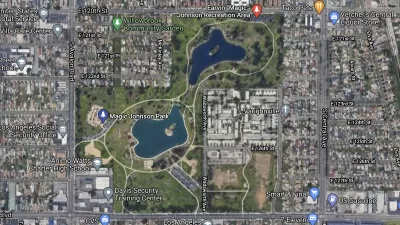Several cities are using mobile park and recreation services to augment existing parks and fill gaps in parks. LA County parks planner Clement Lau describes a sampling of mobile programs.
Many neighborhoods are park-starved, which undermines the health of their residents and the development of their children. Focusing only on permanent land-based park space ignores current needs. Actual open space parks can take a decade or more to put into place. Clement Lau, a Los Angeles County planner writes about a nimble approach adopted by several cities. These cities provide park and recreation services to underserved neighborhoods and populations by going mobile. While not intended replace real parks, this approach can mitigate the absence of parks before the root problem is fixed. The cities implementing such an approach include New York; San Francisco; Los Angeles; Cape Coral, Florida; and Boise, Idaho. The services are provided either as pop-up events, by mobile van, or scheduled programming. Services vary widely and can include hard goods like skateboard ramps, soccer goals, and basketball hoops, or soft goods like yoga classes, coaches, and volunteers to teach and play sports with children, and registration for camps. For example, writes Lau:
The City of Los Angeles Department of Recreation and Parks is planning to launch a mobile recreation program to bring a variety of outdoor activities to children and families in under-served communities. Each mobile recreation vehicle will provide differently themed activities ranging from sports to drama and dance to STEM activities. The program will commence on the weekends at four elementary schools in high park need areas.
For more detailed information on how cities are filling the gaps in parks, please see the source article.
FULL STORY: Meeting Park Needs Through Mobile Recreation

Alabama: Trump Terminates Settlements for Black Communities Harmed By Raw Sewage
Trump deemed the landmark civil rights agreement “illegal DEI and environmental justice policy.”

Planetizen Federal Action Tracker
A weekly monitor of how Trump’s orders and actions are impacting planners and planning in America.

The 120 Year Old Tiny Home Villages That Sheltered San Francisco’s Earthquake Refugees
More than a century ago, San Francisco mobilized to house thousands of residents displaced by the 1906 earthquake. Could their strategy offer a model for the present?

In Both Crashes and Crime, Public Transportation is Far Safer than Driving
Contrary to popular assumptions, public transportation has far lower crash and crime rates than automobile travel. For safer communities, improve and encourage transit travel.

Report: Zoning Reforms Should Complement Nashville’s Ambitious Transit Plan
Without reform, restrictive zoning codes will limit the impact of the city’s planned transit expansion and could exclude some of the residents who depend on transit the most.

Judge Orders Release of Frozen IRA, IIJA Funding
The decision is a victory for environmental groups who charged that freezing funds for critical infrastructure and disaster response programs caused “real and irreparable harm” to communities.
Urban Design for Planners 1: Software Tools
This six-course series explores essential urban design concepts using open source software and equips planners with the tools they need to participate fully in the urban design process.
Planning for Universal Design
Learn the tools for implementing Universal Design in planning regulations.
Clanton & Associates, Inc.
Jessamine County Fiscal Court
Institute for Housing and Urban Development Studies (IHS)
City of Grandview
Harvard GSD Executive Education
Toledo-Lucas County Plan Commissions
Salt Lake City
NYU Wagner Graduate School of Public Service





























